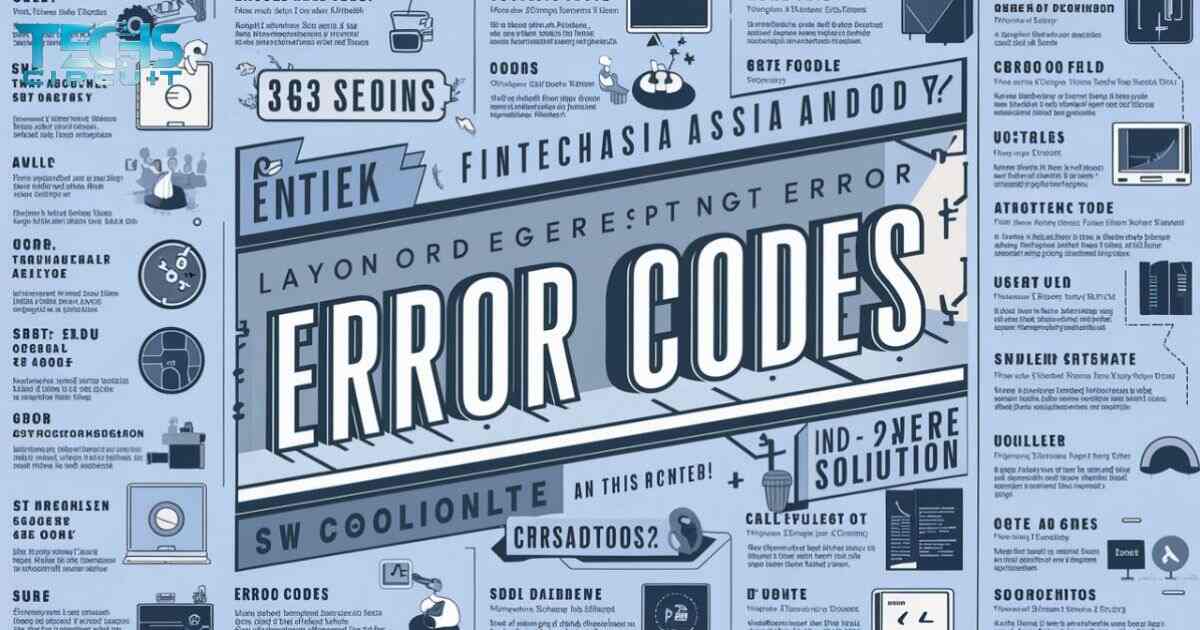FintechAsia is a leading financial technology platform in Asia. It uses a comprehensive error code system. This system helps identify and resolve issues quickly. Understanding these codes is crucial for smooth operations.
Error codes are essential in the fintech world. They provide valuable information about system issues. FintechAsia’s error code system is designed for efficiency. It helps users and developers quickly pinpoint problems.
The Importance of Error Codes in Fintech
Error codes play a vital role in fintech platforms. They ensure system reliability. They help maintain security. Error codes also improve user experience. Quick issue resolution is key in financial transactions.
Overview of FintechAsia’s Error Code Structure
FintechAsia uses a structured error code system. Each code has a specific format. It includes a prefix and a numeric identifier. This structure allows for easy categorization of issues.
Types of FintechAsia Error Codes
FintechAsia categorizes error codes into several types. Each type relates to a specific area of the platform. Understanding these categories helps in quicker problem-solving.
Authentication Errors
Authentication errors are common in fintech platforms. They occur when users try to access the system. These errors often relate to login issues.
Common authentication errors include:
- Invalid credentials
- Expired sessions
- Account lockouts
- Two-factor authentication failures
API-Related Errors
API errors occur during data exchange. They can affect various operations. These errors are crucial for developers to understand.
API error examples:
- Rate limit exceeded
- Invalid API key
- Incorrect endpoint
- Data format mismatch
Transaction Processing Errors
Transaction errors directly impact financial operations. They can occur at different stages of a transaction. Quick resolution is essential for these errors.
Examples of transaction errors:
- Insufficient funds
- Invalid account number
- Currency conversion failure
- Transaction timeout
System and Infrastructure Errors
These errors relate to the platform’s technical infrastructure. They can affect overall system performance. Resolving these often requires technical expertise.
Infrastructure error types:
- Server downtime
- Database connection issues
- Network failures
- Cache invalidation problems
Compliance and Regulatory Errors
Compliance errors are critical in the fintech sector. They ensure adherence to financial regulations. These errors help maintain legal and regulatory standards.
Compliance error examples:
- KYC verification failure
- Transaction limit exceeded
- Suspicious activity detection
- Regulatory reporting issues
Common Causes of FintechAsia Error Codes

Understanding the root causes of errors is crucial. It helps in preventing future occurrences. Many factors can lead to error codes in FintechAsia.
Network and Connectivity Issues
Network problems are a frequent cause of errors. They can disrupt various platform functions. Connectivity issues can lead to transaction failures.
Common network-related causes:
- Internet outages
- Firewall restrictions
- DNS resolution problems
- VPN connection failures
User Input Errors
User mistakes often trigger error codes. These can range from simple typos to more complex input errors. Proper user education can reduce these occurrences.
Examples of user input errors:
- Incorrect password entry
- Invalid account numbers
- Wrong transaction amounts
- Mismatched recipient details
System Overload and Performance Issues
High traffic can strain the system. This leads to various error codes. Performance issues can affect user experience significantly.
Causes of system overload:
- High transaction volume
- Inadequate server resources
- Inefficient database queries
- Unoptimized code
Third-Party Integration Failures
FintechAsia relies on various external services. Issues with these integrations can cause errors. Maintaining these connections is crucial for smooth operations.
Integration failure examples:
- Payment gateway timeouts
- Data sync errors with banks
- API changes in partner services
- External service downtime
Security-Related Triggers
Security measures can sometimes trigger error codes. These are designed to protect the platform and its users. Understanding these triggers is important for both users and administrators.
Security-related error causes:
- Suspicious IP addresses
- Unusual transaction patterns
- Multiple failed login attempts
- Encryption key mismatches
Diagnosing FintechAsia Error Codes

Effective diagnosis is key to resolving error codes. FintechAsia provides tools and methods for this. Proper diagnosis leads to quicker resolution.
Using the Error Code Database
FintechAsia maintains a comprehensive error code database. It’s a valuable resource for troubleshooting. Users and developers can access detailed information here.
Steps to use the database:
- Note the exact error code
- Access the FintechAsia error database
- Search for the specific code
- Review the provided information and solutions
Analyzing Error Logs
Error logs contain crucial diagnostic information. They provide context for error occurrences. Analyzing these logs can reveal patterns and root causes.
Key points in log analysis:
- Check timestamps of errors
- Look for recurring patterns
- Identify related system events
- Review user actions leading to errors
Utilizing Monitoring Tools
FintechAsia offers various monitoring tools. These help in real-time error detection. They also assist in predicting potential issues.
Benefits of monitoring tools:
- Real-time error alerts
- Performance metrics tracking
- System health overview
- Trend analysis for proactive measures
Collecting User Feedback
User reports are valuable in error diagnosis. They provide real-world context to errors. Collecting and analyzing this feedback is crucial.
Methods for gathering user feedback:
- In-app error reporting features
- Customer support tickets
- User surveys
- Community forums
Solutions for Common FintechAsia Error Codes

Many FintechAsia error codes have standard solutions. Knowing these can speed up the resolution process. Here are solutions for some common errors.
Resolving Authentication Errors
Authentication errors often have straightforward solutions. They typically involve user actions or account settings.
Solutions for authentication errors:
- Reset password
- Verify account details
- Check for account locks
- Update security settings
Fixing API-Related Issues
API errors usually require technical interventions. Developers play a key role in resolving these.
Steps to fix API issues:
- Verify API credentials
- Check endpoint URLs
- Review rate limit policies
- Update API integration code
Addressing Transaction Failures
Transaction errors need careful handling. They directly affect financial operations. Quick and accurate resolution is crucial.
Approaches to resolve transaction errors:
- Verify account balances
- Check transaction limits
- Ensure correct recipient details
- Review currency conversion settings
Tackling System and Infrastructure Problems
System-level issues often need expert intervention. They may require coordination with the FintechAsia technical team.
Methods to address system problems:
- Perform system diagnostics
- Update server configurations
- Optimize database queries
- Scale infrastructure resources
Managing Compliance and Regulatory Errors
Compliance errors require a thorough understanding of regulations. Resolving these often involves legal and compliance teams.
Steps to manage compliance errors:
- Review regulatory requirements
- Update KYC information
- Adjust transaction limits
- Enhance monitoring systems
Best Practices for Error Prevention

Preventing errors is as important as resolving them. FintechAsia recommends several best practices. These help in minimizing error occurrences.
Regular System Maintenance
Regular maintenance keeps the system healthy. It prevents many common errors. Scheduled maintenance is crucial for optimal performance.
Key maintenance tasks:
- Software updates
- Database optimization
- Security patch installations
- Performance tuning
Implementing Robust Error Handling
Good error handling improves system reliability. It helps in graceful error management. Proper implementation reduces the impact of errors.
Error handling best practices:
- Implement try-catch blocks
- Use descriptive error messages
- Log errors comprehensively
- Provide user-friendly error notifications
Continuous Monitoring and Alerting
Proactive monitoring helps catch issues early. It allows for quick responses to potential problems. Effective alerting systems are crucial.
Benefits of continuous monitoring:
- Early error detection
- Performance trend analysis
- Capacity planning insights
- Rapid incident response
User Education and Training
Educated users make fewer mistakes. Providing clear guidelines reduces error occurrences. Regular training sessions can be beneficial.
Areas for user education:
- Proper account management
- Secure transaction practices
- Understanding error messages
- Reporting issues effectively
Regular Code Reviews and Testing
Quality code leads to fewer errors. Regular reviews and testing catch issues early. This practice improves overall system stability.
Importance of code reviews and testing:
- Identify potential bugs
- Ensure code quality
- Improve system reliability
- Enhance performance
Advanced Error Handling Techniques
Advanced techniques can further improve error management. These methods help in complex scenarios. They offer more sophisticated solutions.
Must Read This Article:Are E26 and A19 the Same Thing?
Implementing Retry Mechanisms
Retry mechanisms help handle temporary failures. They can resolve issues automatically. This reduces manual intervention needs.
Benefits of retry mechanisms:
- Handles transient errors
- Improves system resilience
- Reduces downtime
- Enhances user experience
Using Circuit Breakers
Circuit breakers prevent cascading failures. They isolate problematic components. This technique protects the overall system health.
Advantages of circuit breakers:
- Prevents system overload
- Isolates failing services
- Enables faster recovery
- Improves system stability
Employing Fallback Strategies
Fallback strategies provide alternatives when errors occur. They ensure continuity of service. This approach enhances system reliability.
Key aspects of fallback strategies:
- Provides alternative workflows
- Maintains core functionality
- Improves user satisfaction
- Reduces error impact
Implementing Chaos Engineering
Chaos engineering tests system resilience. It intentionally introduces errors. This practice helps identify weaknesses proactively.
Benefits of chaos engineering:
- Identifies hidden issues
- Improves system robustness
- Enhances error recovery processes
- Builds confidence in system reliability
Future Trends in Error Management

The field of error management is evolving. New technologies are changing how we handle errors. FintechAsia is at the forefront of these developments.
AI and Machine Learning in Error Prediction
AI is revolutionizing error management. Machine learning algorithms can predict errors. This allows for preemptive actions.
Potential of AI in error management:
- Predictive error detection
- Automated root cause analysis
- Intelligent error classification
- Self-healing systems
Blockchain for Enhanced Transaction Tracking
Blockchain technology offers new possibilities. It can improve transaction error tracking. This technology enhances transparency and security.
Advantages of blockchain in error management:
- Immutable transaction records
- Enhanced error traceability
- Improved dispute resolution
- Increased transaction security
Enhanced User Interfaces for Error Reporting
Better interfaces can improve error reporting. They make it easier for users to provide feedback. This leads to quicker and more accurate error resolution.
Features of advanced error reporting interfaces:
- Intuitive error submission forms
- Real-time error status updates
- Interactive troubleshooting guides
- Seamless communication channels
Integration of IoT for Real-time Monitoring
IoT devices can enhance error monitoring. They provide real-time data on system performance. This allows for quicker error detection and response.
Benefits of IoT in error management:
- Continuous system health monitoring
- Immediate error notifications
- Enhanced data collection for analysis
- Improved response times
Must Read This Article:Top 15 Soap2day Alternatives: Watch The Latest Hits Of Movies And Series For Free
FAQ’s
What is the most common FintechAsia error code?
The most common error is AUTH-001, indicating authentication issues. It usually occurs due to incorrect login credentials or expired sessions.
How can I prevent API rate limit errors?
Implement proper request throttling in your application. Also, consider upgrading your API plan for higher limits if needed.
What should I do if I encounter a transaction failure error?
First, verify the transaction details and account balance. If the issue persists, contact FintechAsia support with the specific error code.
Are there any tools to simulate FintechAsia errors for testing?
Yes, FintechAsia provides a sandbox environment. It allows developers to simulate various error scenarios for testing purposes.
How often does FintechAsia update its error code system?
FintechAsia regularly updates its error code system. Major updates typically occur quarterly, with minor updates more frequently.
Conclusion
Understanding FintechAsia error codes is crucial for efficient platform use. These codes provide valuable insights into system issues. They enable quick problem resolution and improve overall reliability.
Staying informed about error codes enhances user experience. It allows for proactive problem-solving. As FintechAsia continues to evolve, its error management system will remain a key focus for improvement and innovation.


















